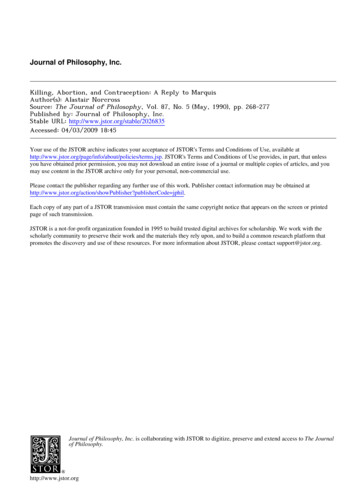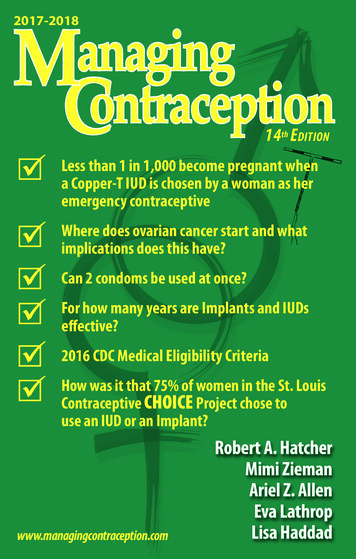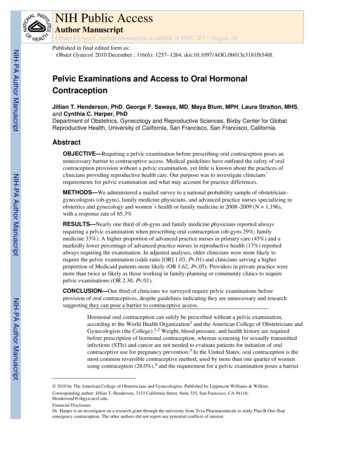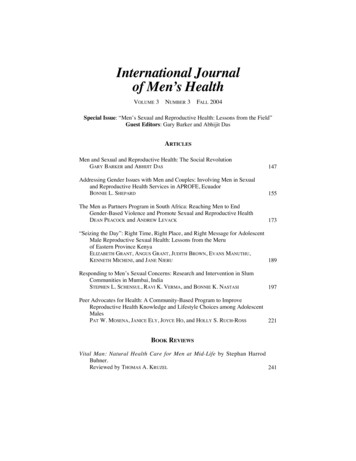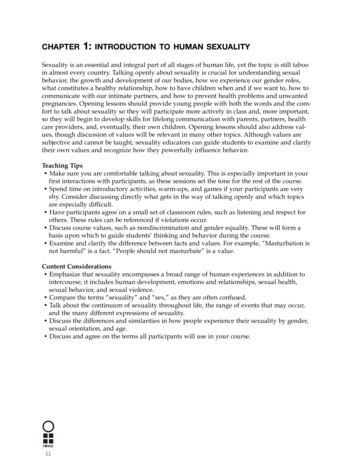
Transcription
ORIGINALARTICLESA Review of Contraception and AbortionContent in Family Medicine TextbooksFinn D. Schubert, MPH; Sarp Aksel, MD; Ariana H. Bennett, MPH; Nancy R. Glassman, MLS, MPH;Marji Gold, MDBACKGROUND AND OBJECTIVES: Family physicians are criticalproviders of reproductive health care in the United States, and family physicians and trainees refer to textbooks as a source of clinical information. This study evaluates the coverage of reproductivehealth topics in current family medicine textbooks.METHODS: We identified 12 common family medicine textbooksthrough a computerized literature search and through the recommendations of a local family medicine clerkship and evaluated24 areas of reproductive health content (comprising contraceptive care, management of early pregnancy loss, and provision ofinduced abortion) for accuracy and thoroughness using criteria thatwe created based on the latest guidelines.RESULTS: All contraceptive methods evaluated were addressedin more than half of the textbooks, though discrepancies existedby method, with intrauterine devices (IUDs), external (male) condoms, and diaphragms addressed most frequently (10/12 texts)and male and female sterilization addressed least frequently (8/12texts). While most contraceptive methods, when addressed, wereusually addressed accurately, IUDs were often addressed inaccurately. Coverage of early pregnancy loss management was limitedto 7/12 texts, and coverage of early abortion methods was evenmore limited, with only 4/12 texts addressing the topic.CONCLUSIONS: Family medicine textbooks do not uniformly provide correct and thorough information on reproductive health topics relevant to family medicine, and attention is needed to ensurethat family physicians are receiving appropriate information andtraining to meet the reproductive health needs of US women.(Fam Med 2015;47(7):524-8.)Nearly all (99%) of reproductive-aged, ever-heterosexually active women have useda contraceptive method other thanperiodic abstinence,1,2 an estimated15%3 to 31%4 of pregnancies end inearly pregnancy loss (EPL), and, atcurrent abortion rates, it is estimated that nearly one-third of women524JULY-AUGUST 2015 VOL. 47, NO. 7will experience induced abortion intheir lifetimes.5 Many women, particularly in rural areas, rely on familyphysicians for these forms of care.6,7Although the vast majority offamily physicians (99%) dispense,prescribe, or recommend oral contraceptive pills,8 and a majority offamily medicine educators reporthaving treated early pregnancy lossin the past year,9 data suggest critical gaps in the family planning services provided by family physicians.For example, family physicians areless likely than obstetrician-gynecologists to offer intrauterine devices(IUDs) to their eligible patients,10,11and many do not offer options other than expectant management forEPL.9 In addition, although nearlythree-quarters of family medicineeducators agree that early inducedabortion is within the scope of family medicine, the majority of familymedicine educators do not offer thisservice.9 Especially now, as healthcare reform moves reproductivehealth care into community healthcenters and community-based practices, family physicians will needadequate reproductive health information and training to prepare themto meet their patients’ reproductivehealth needs.Despite the increasing availability of online journals and databases, textbooks continue to serve asimportant sources of informationfor family medicine physicians andtrainees. Although data on this topic is limited, a recent study of dental students across North AmericaFrom RHEDI/Reproductive Health Educationin Family Medicine, Montefiore Medical Center,New York, NY (Mr Schubert); Albert EinsteinCollege of Medicine, Bronx, NY (Dr Aksel); D.Samuel Gottesman Library (Ms Glassman),and Department of Family and Social Medicine,Albert Einstein College of Medicine (Dr Gold,Ms Bennett).FAMILY MEDICINE
ORIGINAL ARTICLESfound that a majority of respondentspreferred traditional resources suchas textbooks as references and foraugmenting lecture material.12 Inaddition, textbook publishers continue to advertise at specialty society meetings to faculty, residents,and students, indicating an apparentmarket for textbooks. New trends inmedical texts allow purchase of select chapters from within textbooks,and use of electronic textbooks (ebooks) is increasing, with over 70%of attending physicians, interns, residents, and fellows at a major USmedical school reporting that theyhave used an e-book.13 Electronic options can potentially expand the useof textbooks, making it that muchmore important that the informationthey contain is correct.The objective of the study was todetermine whether information infamily medicine textbooks used inthe United States is complete, correct, and in accord with latest practice guidelines in order to identifystrategies for addressing the documented gaps in reproductive healthcare provided by family physicians.MethodsWe identified and reviewed 12 family medicine textbooks in summer2011 (Table 1). The textbooks werechosen for review from a computerized literature search of family medicine textbook titles and from the listof textbooks recommended by AlbertEinstein College of Medicine’s thirdyear family medicine clerkship. Textbooks were included if published inthe previous 10 years (since 2001)and available in print or throughelectronic publication. If multipleeditions of a textbook met the inclusion criteria, only the latest version was used. Institutional ReviewBoard approval was not required forthe study because it did not involvehuman subjects.Four researchers (FS, SA, AB, MG)created the standardized evaluationschema to evaluate textbook contentin 24 areas of reproductive healthknowledge that the AccreditationCouncil for Graduate Medical Education has deemed requirementsfor resident medical knowledge14 andthat fall within the scope of practiceof family medicine. This paper presents 20 of the most salient topics,including contraceptive methods,contraceptive counseling, management of EPL, and induced abortion.Fertility awareness-based methodswere not included in this review because of the wide range of approaches that fall under this umbrellaterm. The scoring system used wasadapted from that previously published by Ogburn and colleagues intheir 2011 study of breast-feeding information in obstetrics and gynecology textbooks.15 An abridged criteriatable is presented in Table 2.A single reviewer (SA) examinedeach text on two separate occasions,using the developed schema as aguide. The senior researcher (MG)supervised this work and examineda selection of reviews against thetextbooks to ensure accuracy andconsistency.ResultsContraceptive MethodsAll contraceptive methods we evaluated were addressed in more thanhalf of the textbooks reviewed. Themethods most commonly addressedwere the hormonal and copperIUDs, external condoms, and the diaphragm, each addressed in 10/12texts. The contraceptive methodsthat received the least coverage werethe contraceptive ring, cervical cap,and contraceptive patch, each addressed in 7/12 textbooks.When a textbook did address aspecific contraceptive method, thatmethod was most often addressedboth correctly and thoroughly, withthe exception of the IUD (Figure 1).Table 1: List of Reviewed Family Medicine Textbooks (in Alphabetical Order by Title)1. C urrent Diagnosis & Treatment in Family Medicine by Jeanette E. South-Paul, Samuel C. Matheny, Evelyn L. Lewis(2011)2. E ssentials of Family Medicine by Philip D. Sloane, Lisa M. Slatt, Mark H. Ebell, Louis B. Jacques, Mindy A. Smith(2008)3. Family Medicine: Ambulatory Care and Prevention by Mark B. Mengel, L. Peter Schwiebert (2009)4. F amily Medicine: Principles and Practice by Robert B. Taylor, Alan K. David, Scott A. Fields, D. Melessa Phillips, JosephE. Scherger (2003)5. Family Medicine Obstetrics by Stephen D. Ratcliffe, Elizabeth G. Baxley, Matthew K. Cline, Ellen L. Sakornbut (2008)6. Obstetrics in Family Medicine by Paul Lyons (2006)7. Pfenniger and Fowler’s Procedures for Primary Care by John L. Pfenninger, Grant C. Fowler (2003)8. Taylor’s Manual of Family Medicine by Paul M. Paulman, Audrey A. Paulman, Jeffrey D. Harrison (2008)9. Textbook of Family Medicine by Ian R. McWhinney, Thomas Freeman (2009)10. Textbook of Family Medicine by Robert E. Rakel, David P. Rakel (2011)11. T he Color Atlas of Family Medicine by Richard P. Usatine, Mindy A. Smith, E.J. Mayeaux Jr, Heidi Chumley, JamesTysinger (2009)12. Woman-Centered Care in Pregnancy and Childbirth by Sara G. Shields; Lucy M. Candib (2010)FAMILY MEDICINEVOL. 47, NO. 7 JULY-AUGUST 2015525
ORIGINAL ARTICLESTable 2: Abridged Criteria Table for Textbook EvaluationContent AreaCriteria for Accurate and AdequateReference Sources1. Sterilization (male)United States MedicalEligibility for ContraceptiveUse,1 Centers for DiseaseControl and PreventionSelected PracticeRecommendations forContraceptive Use,2Contraceptive Technology32. Sterilization (female)3. Levonorgestrel IUD4. Copper IUD5. D epot medroxyprogesterone acetate(DMPA) injection6. Etonogestrel implantEvidence-based information was presentedregarding the mechanism of action of themethod, common side effects, patient medicaleligibility, and associated risks and benefits.7. Contraceptive patch8. Contraceptive ring9. Combined oral contraceptive pill10. Progestin-only contraceptive pill11. External (male) condom12. Internal (female) condom13. Diaphragm14. Cervical cap15. L evonorgestrel post-coital (emergency)contraception16. Approaches to contraceptive counseling Discussion of considerations in contraceptivecounseling include at least: methodconvenience, plans for future fertility, methodconfidentiality, and impact of co-morbiditiesand lifestyle habits on method selection.Contraceptive Technology317. U nintended pregnancy optionscounselingAbortion, adoption, and parenting options areall covered in detail, factually, and withoutapparent bias. Patient-centered approaches tooptions counseling are presented.Management of Unintendedand Abnormal Pregnancy:Comprehensive AbortionCare418. First trimester aspiration abortionManual and electric vacuum aspirationprocedures are covered factually and in detail.19. First trimester medication abortionMedication abortion regimens are presentedin detail; evidence-based regimen ispresented in addition to the Food and DrugAdministration-approved protocol.20. In-office EPL managementExpectant management, medication, andaspiration are all presented accurately andas within the scope of practice for familyphysicians.Prine LW, MacNaughton H.Office management of earlypregnancy loss. Am FamPhysician 2011;84(1):75-82.1. US medical eligibility criteria for contraceptive use, 2010, at a1.htm?scid rr59e0528a1 e#box1.2. US selected practice recommendations for contraceptive use, 2013, at htm?s cid rr6205a1 w.3. Hatcher RA, Trussell J, Nelson A, Cates W, Stewart FH, Kowal D. Contraceptive technology, 19th edition. Ardent Media, Inc, 2007.4. Paul M, Lichtenberg ES, Borgatta L, Grimes DA, Stubblefield PG, Creinin MD. Management of unintended and abnormal pregnancy: comprehensiveabortion care. Wiley-Blackwell, 2009.Management of Early PregnancyLoss and Induced AbortionSeven of the 12 textbooks addressedin-office management of EPL, andfive of those did so correctly andthoroughly. By contrast, only onethird of textbooks (4/12) addressed526JULY-AUGUST 2015 VOL. 47, NO. 7unintended pregnancy optionscounseling, aspiration abortion, andmedication abortion. These fourbooks addressed all three of thesetopics, while the other eight booksaddressed none of them. Of thosebooks that addressed unintendedpregnancy options counseling andabortion, half (two books) addressedoptions counseling and medicationabortion correctly and thoroughly,and only one book addressed aspiration abortion correctly and thoroughly (Figure 1).FAMILY MEDICINE
ORIGINAL ARTICLESFigure 1: Textbooks Addressing Selected TopicsDiscussionDespite the fact that family physicians play a vital role in reproductivehealth care delivery, particularly inrural and underserved areas,6 several topics were routinely omittedfrom discussion across the reviewedtexts. While contraceptive methodsare addressed in the majority of textbooks, highly effective methods suchas sterilization are often omitted,and information provided regardingIUDs is frequently inaccurate. Fewerthan half of reviewed textbooks addressed management of EPL correctly and thoroughly, and only one-thirdof textbooks addressed pregnancy options counseling and early abortionmethods, with only one book providing correct and thorough informationon aspiration abortion.Although some of the gaps in coverage identified by our study may beattributable to changes in practiceFAMILY MEDICINEguidelines after the books were published, the books reviewed in thestudy were all in wide circulationand reflected the most recent available edition of each text. This studydoes not seek to evaluate whethereach textbook was accurate at thetime of its publication but rather todescribe the quality of informationon these topics available to traineesthrough widely available textbooks.The results from this study indicatethat family medicine textbooks arenot a universally accurate sourceof information on certain highly effective contraceptive methods andthat textbooks frequently omit information about EPL managementand early abortion, despite the factthat a majority of family medicineeducators consider these to be within the scope of practice for familymedicine.9The results from this study raisequestions that warrant further research—how is post-residency practice impacted by the clinical anddidactic training received duringmedical school and residency? Doesthe lack of coverage of reproductivehealth topics in family medicine textbooks influence medical studentswho are deciding between familymedicine and obstetrics-gynecology? Are trainees receiving accurateinformation on these topics throughother resources, or are these gaps intextbooks reflective of wider gaps intrainee knowledge in these areas?Our results raise concerns thatfamily physicians may not be adequately prepared to provide a fullspectrum of reproductive healthservices, and this concern is compounded by the fact that passage ofthe Patient Protection and Affordable Care Act and its authorizationVOL. 47, NO. 7 JULY-AUGUST 2015527
ORIGINAL ARTICLESof the Primary Care Extension Program—a program aimed at promoting increased access to primary careservices at the local level throughoutthe country16—has set the stage forfamily physicians to have an evenbigger impact on the nation’s healththan ever before. Ensuring that family physicians are adequately trainedto provide this range of services iscritical to ensuring access to theseservices for US women, especiallyin rural areas. In particular, severalstudies have demonstrated that family physicians follow overly restrictive, non-evidence-based criteria indetermining which patients are eligible for IUDs,11,17-19 which could significantly impact women’s ability toaccess these highly effective forms ofcontraception.Despite the concerns raised bythis study, it is worth noting thatthree of the reviewed texts (Textbook of Family Medicine by RobertE. Rakel and David P. Rakel; Women-Centered Care in Pregnancy andChildbirth by Sara G. Shields andLucy M. Candib; The Color Atlas ofFamily Medicine by Richard P. Usatine, Mindy A. Smith, E.J. MayeauxJr, Heidi Chumley, and James Tysinger) accurately addressed at least17 of the 20 criteria and containedno inaccurate or inconsistent information.A limitation of this study is thatfamily medicine is a broadly encompassing medical specialty, andas such, publishers may have beenforced to make decisions about whichtopics to include in their textbooks.The type of text and the target audience may also have influencedwhether a particular title includedcomprehensive discussion of all areas of reproductive health care. Forexample, texts that focus on diagnostic knowledge may not includeinformation on procedures, suchas aspiration procedures for miscarriage management and inducedabortion. Books intended for students may contain a different profile528JULY-AUGUST 2015 VOL. 47, NO. 7of information than those meant forresident physicians. Even so, theprevalence of inaccurate informationabout certain topics raises seriousconcerns. An additional limitationwas that the review of textbook content was not blinded and may haveraised the possibility for bias due tothe impact of the reviewer’s opinionsand prior knowledge of certain texts.In spite of the limitations mentioned above, our study identifies agap in reproductive health information in family medicine textbooks.Particularly as family physicianswill increasingly be called upon toprovide reproductive health care, further research is needed to determinethe quality of reproductive health education that family medicine trainees are currently receiving, and toevaluate interventions to improvesuch education.ACKNOWLEDGMENTS: Preliminary resultsfrom this study were presented as a posterat the 2012 Annual Meeting of the NationalAbortion Federation, Vancouver, BC, the 2012Northeast Regional Meeting of the FamilyMedicine Education Consortium, Cleveland,OH; and the 2012 Annual Meeting of theNorth American Primary Care ResearchGroup, New Orleans, LA.The authors would like to thank CaraHerbitter for her help in the formulation ofthis project and Lauren M. Casey for reviewingdrafts of the manuscript.CORRESPONDING AUTHOR: Address correspondence to Dr Aksel, Albert Einstein Collegeof Medicine, 1300 Morris Park Avenue, Bronx,NY 10461. 518-598-2274. Fax: 866-267-0699.sarp.aksel@gmail.comReferences1. Mosher WD, Jones J. Use of contraception inthe United States: 1982-2008. Vital HealthStat 23 2010 Aug;(29):1-44.2. Jones RK, Dreweke J. Countering conventionalwisdom: new evidence on religion and contraceptive use. Guttmacher Institute, 2011.3. Ventura S, Mosher WD, Curtin S, Abma J, Henshaw S. Trends in pregnancies and pregnancyrates by outcome: estimates for the UnitedStates, 1976–96. Vital Health Stat 2000;21.4. Wilcox AJ, Weinberg CR, O’Connor JF, et al.Incidence of early loss of pregnancy. N Engl JMed 1988;319:189-94.6. Cohen D, Coco A. Trends in the provision ofpreventive women’s health services by familyphysicians. Fam Med 2011;43:166-71.7. Kozhimannil KB, Fontaine P. Care from familyphysicians reported by pregnant women in theUnited States. Ann Fam Med 2013;11:350-4.8. Landry DJ, Wei J, Frost JJ. Public and private providers’ involvement in improving theirpatients’ contraceptive use. Contraception2008;78:42-51.9. Herbitter C, Bennett A, Schubert FD, Bennett IM, Gold M. Management of early pregnancy failure and induced abortion by familymedicine educators. J Am Board Fam Med2013;26:751-8.10. Rubin SE, Fletcher J, Stein T, Segall-Gutierrez P, Gold M. Determinants of intrauterinecontraception provision among US familyphysicians: a national survey of knowledge,attitudes, and practice. Contraception 2011;83:472-8.11. Callegari LS, Darney BG, Godfrey EM, Sementi O, Dunsmoor-Su R, Prager SW. Evidence-based selection of candidates for thelevonorgestrel intrauterine device (IUD). J AmBoard Fam Med 2014;27(1):26-33.12. Ditmyer MM, Dye J, Guirguis N, et al. Electronic vs. traditional textbook use: dental students’ perceptions and study habits. J DentEduc 2012;76:728-38.13. Folb BL, Wessel CB, Czechowski LJ. Clinical and academic use of electronic and printbooks: the Health Sciences Library Systeme-book study at the University of Pittsburgh.Journal of the Medical Library Association:JMLA 2011;99:218-28.14. ACGME Program Requirements for Graduate Medical Education in Family Medicine.Chicago: Accreditation Council for GraduateMedical Education, 2007.15. Ogburn T, Philipp BL, Espey E, MerewoodA, Espindola D. Assessment of breastfeedinginformation in general obstetrics and gynecology textbooks. Journal of Human Lactation:Official Journal of International LactationConsultant Association 2011;27:58-62.16. Phillips RL Jr, Kaufman A, Mold JW, et al. Theprimary care extension program: a catalyst forchange. Ann Fam Med 2013;11:173-8.17. Tyler CP, Whiteman MK, Zapata LB, CurtisKM, Hillis SD, Marchbanks PA. Health careprovider attitudes and practices related tointrauterine devices for nulliparous women.Obstet Gynecol 2012;119:762-71.18. Dehlendorf C, Levy K, Ruskin R, Steinauer J.Health care providers’ knowledge about contraceptive evidence: a barrier to quality familyplanning care? Contraception 2010;81:292-8.19. Rubin SE, Campos G, Markens S. Primary carephysicians’ concerns may affect adolescents’access to intrauterine contraception. J PrimCare Community Health 2013 Jul 1;4(3):216-9.5. Jones RK, Kavanaugh ML. Changes in abortion rates between 2000 and 2008 and lifetime incidence of abortion. Obstet Gynecol2011;117:1358-66.FAMILY MEDICINE
ily medicine textbooks in summer 2011 (Table 1). The textbooks were chosen for review from a computer-ized literature search of family medi-cine textbook titles and from the list of textbooks recommended by Albert Einstein College of Medicine's third- year family medicine clerkship. Text-books were included if published in
